Project and Program Information & Communication Systems
VerifiedAdded on 2021/05/31
|17
|4483
|51
AI Summary
Contribute Materials
Your contribution can guide someone’s learning journey. Share your
documents today.
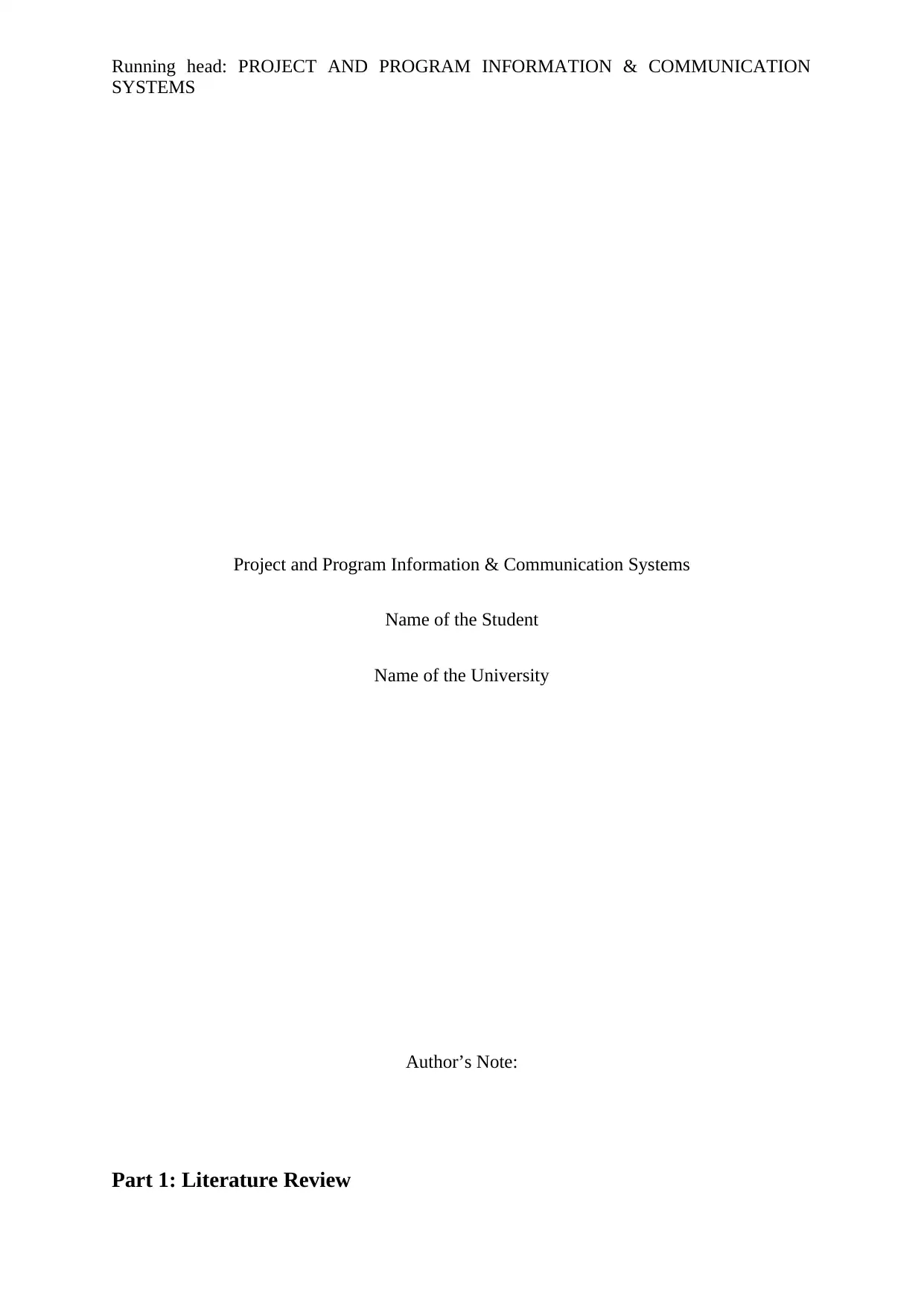
Running head: PROJECT AND PROGRAM INFORMATION & COMMUNICATION
SYSTEMS
Project and Program Information & Communication Systems
Name of the Student
Name of the University
Author’s Note:
Part 1: Literature Review
SYSTEMS
Project and Program Information & Communication Systems
Name of the Student
Name of the University
Author’s Note:
Part 1: Literature Review
Secure Best Marks with AI Grader
Need help grading? Try our AI Grader for instant feedback on your assignments.
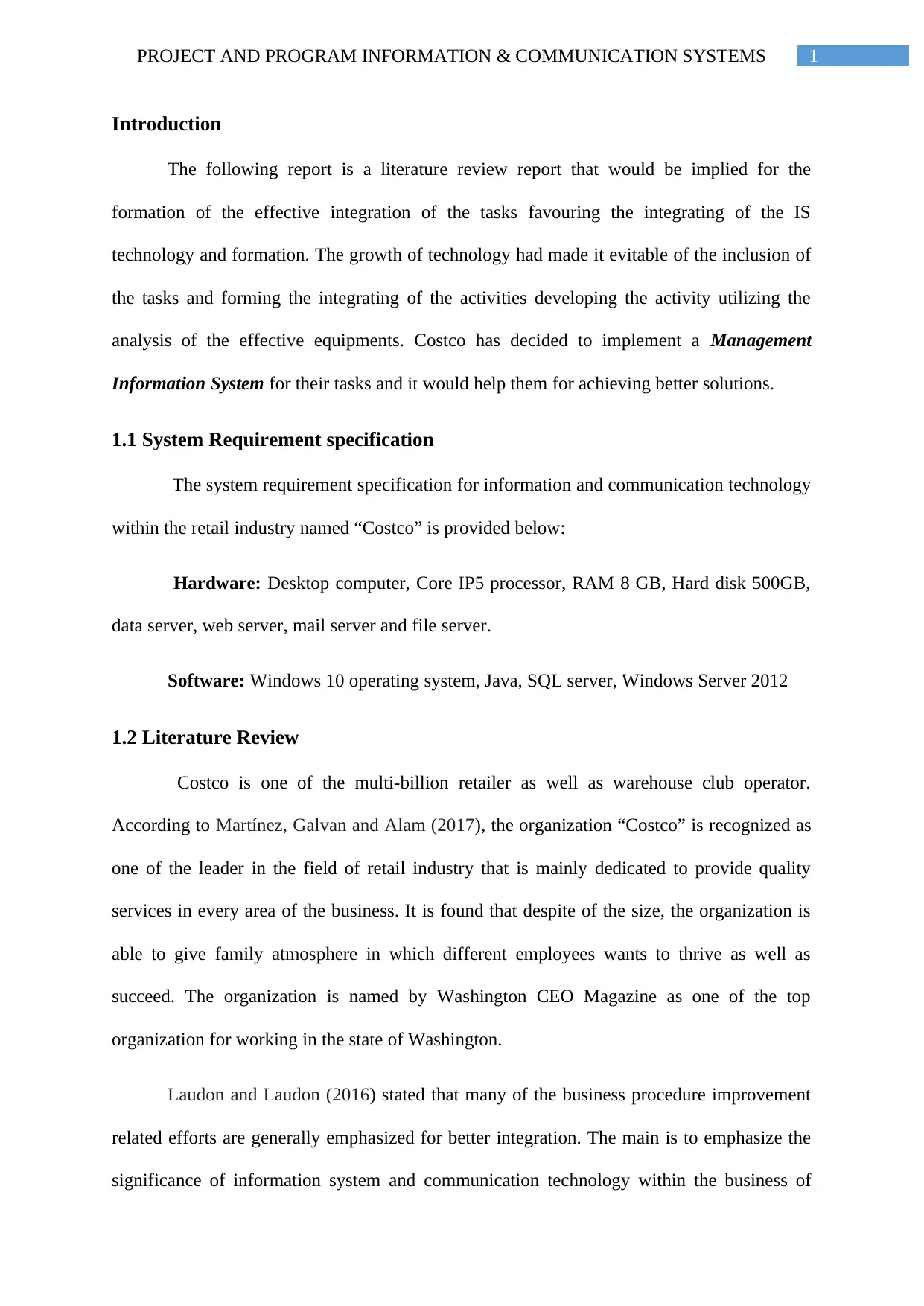
1PROJECT AND PROGRAM INFORMATION & COMMUNICATION SYSTEMS
Introduction
The following report is a literature review report that would be implied for the
formation of the effective integration of the tasks favouring the integrating of the IS
technology and formation. The growth of technology had made it evitable of the inclusion of
the tasks and forming the integrating of the activities developing the activity utilizing the
analysis of the effective equipments. Costco has decided to implement a Management
Information System for their tasks and it would help them for achieving better solutions.
1.1 System Requirement specification
The system requirement specification for information and communication technology
within the retail industry named “Costco” is provided below:
Hardware: Desktop computer, Core IP5 processor, RAM 8 GB, Hard disk 500GB,
data server, web server, mail server and file server.
Software: Windows 10 operating system, Java, SQL server, Windows Server 2012
1.2 Literature Review
Costco is one of the multi-billion retailer as well as warehouse club operator.
According to Martínez, Galvan and Alam (2017), the organization “Costco” is recognized as
one of the leader in the field of retail industry that is mainly dedicated to provide quality
services in every area of the business. It is found that despite of the size, the organization is
able to give family atmosphere in which different employees wants to thrive as well as
succeed. The organization is named by Washington CEO Magazine as one of the top
organization for working in the state of Washington.
Laudon and Laudon (2016) stated that many of the business procedure improvement
related efforts are generally emphasized for better integration. The main is to emphasize the
significance of information system and communication technology within the business of
Introduction
The following report is a literature review report that would be implied for the
formation of the effective integration of the tasks favouring the integrating of the IS
technology and formation. The growth of technology had made it evitable of the inclusion of
the tasks and forming the integrating of the activities developing the activity utilizing the
analysis of the effective equipments. Costco has decided to implement a Management
Information System for their tasks and it would help them for achieving better solutions.
1.1 System Requirement specification
The system requirement specification for information and communication technology
within the retail industry named “Costco” is provided below:
Hardware: Desktop computer, Core IP5 processor, RAM 8 GB, Hard disk 500GB,
data server, web server, mail server and file server.
Software: Windows 10 operating system, Java, SQL server, Windows Server 2012
1.2 Literature Review
Costco is one of the multi-billion retailer as well as warehouse club operator.
According to Martínez, Galvan and Alam (2017), the organization “Costco” is recognized as
one of the leader in the field of retail industry that is mainly dedicated to provide quality
services in every area of the business. It is found that despite of the size, the organization is
able to give family atmosphere in which different employees wants to thrive as well as
succeed. The organization is named by Washington CEO Magazine as one of the top
organization for working in the state of Washington.
Laudon and Laudon (2016) stated that many of the business procedure improvement
related efforts are generally emphasized for better integration. The main is to emphasize the
significance of information system and communication technology within the business of
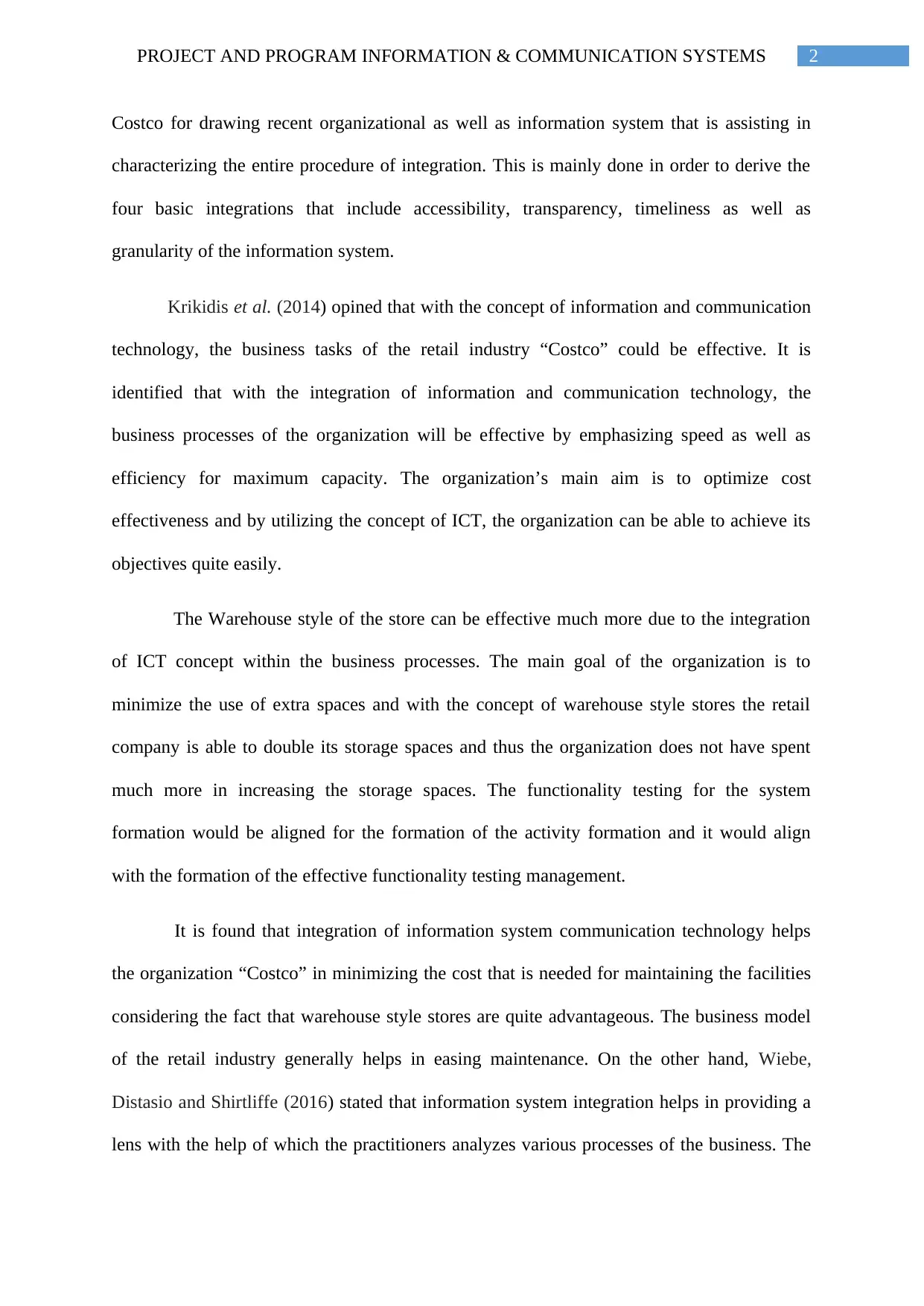
2PROJECT AND PROGRAM INFORMATION & COMMUNICATION SYSTEMS
Costco for drawing recent organizational as well as information system that is assisting in
characterizing the entire procedure of integration. This is mainly done in order to derive the
four basic integrations that include accessibility, transparency, timeliness as well as
granularity of the information system.
Krikidis et al. (2014) opined that with the concept of information and communication
technology, the business tasks of the retail industry “Costco” could be effective. It is
identified that with the integration of information and communication technology, the
business processes of the organization will be effective by emphasizing speed as well as
efficiency for maximum capacity. The organization’s main aim is to optimize cost
effectiveness and by utilizing the concept of ICT, the organization can be able to achieve its
objectives quite easily.
The Warehouse style of the store can be effective much more due to the integration
of ICT concept within the business processes. The main goal of the organization is to
minimize the use of extra spaces and with the concept of warehouse style stores the retail
company is able to double its storage spaces and thus the organization does not have spent
much more in increasing the storage spaces. The functionality testing for the system
formation would be aligned for the formation of the activity formation and it would align
with the formation of the effective functionality testing management.
It is found that integration of information system communication technology helps
the organization “Costco” in minimizing the cost that is needed for maintaining the facilities
considering the fact that warehouse style stores are quite advantageous. The business model
of the retail industry generally helps in easing maintenance. On the other hand, Wiebe,
Distasio and Shirtliffe (2016) stated that information system integration helps in providing a
lens with the help of which the practitioners analyzes various processes of the business. The
Costco for drawing recent organizational as well as information system that is assisting in
characterizing the entire procedure of integration. This is mainly done in order to derive the
four basic integrations that include accessibility, transparency, timeliness as well as
granularity of the information system.
Krikidis et al. (2014) opined that with the concept of information and communication
technology, the business tasks of the retail industry “Costco” could be effective. It is
identified that with the integration of information and communication technology, the
business processes of the organization will be effective by emphasizing speed as well as
efficiency for maximum capacity. The organization’s main aim is to optimize cost
effectiveness and by utilizing the concept of ICT, the organization can be able to achieve its
objectives quite easily.
The Warehouse style of the store can be effective much more due to the integration
of ICT concept within the business processes. The main goal of the organization is to
minimize the use of extra spaces and with the concept of warehouse style stores the retail
company is able to double its storage spaces and thus the organization does not have spent
much more in increasing the storage spaces. The functionality testing for the system
formation would be aligned for the formation of the activity formation and it would align
with the formation of the effective functionality testing management.
It is found that integration of information system communication technology helps
the organization “Costco” in minimizing the cost that is needed for maintaining the facilities
considering the fact that warehouse style stores are quite advantageous. The business model
of the retail industry generally helps in easing maintenance. On the other hand, Wiebe,
Distasio and Shirtliffe (2016) stated that information system integration helps in providing a
lens with the help of which the practitioners analyzes various processes of the business. The
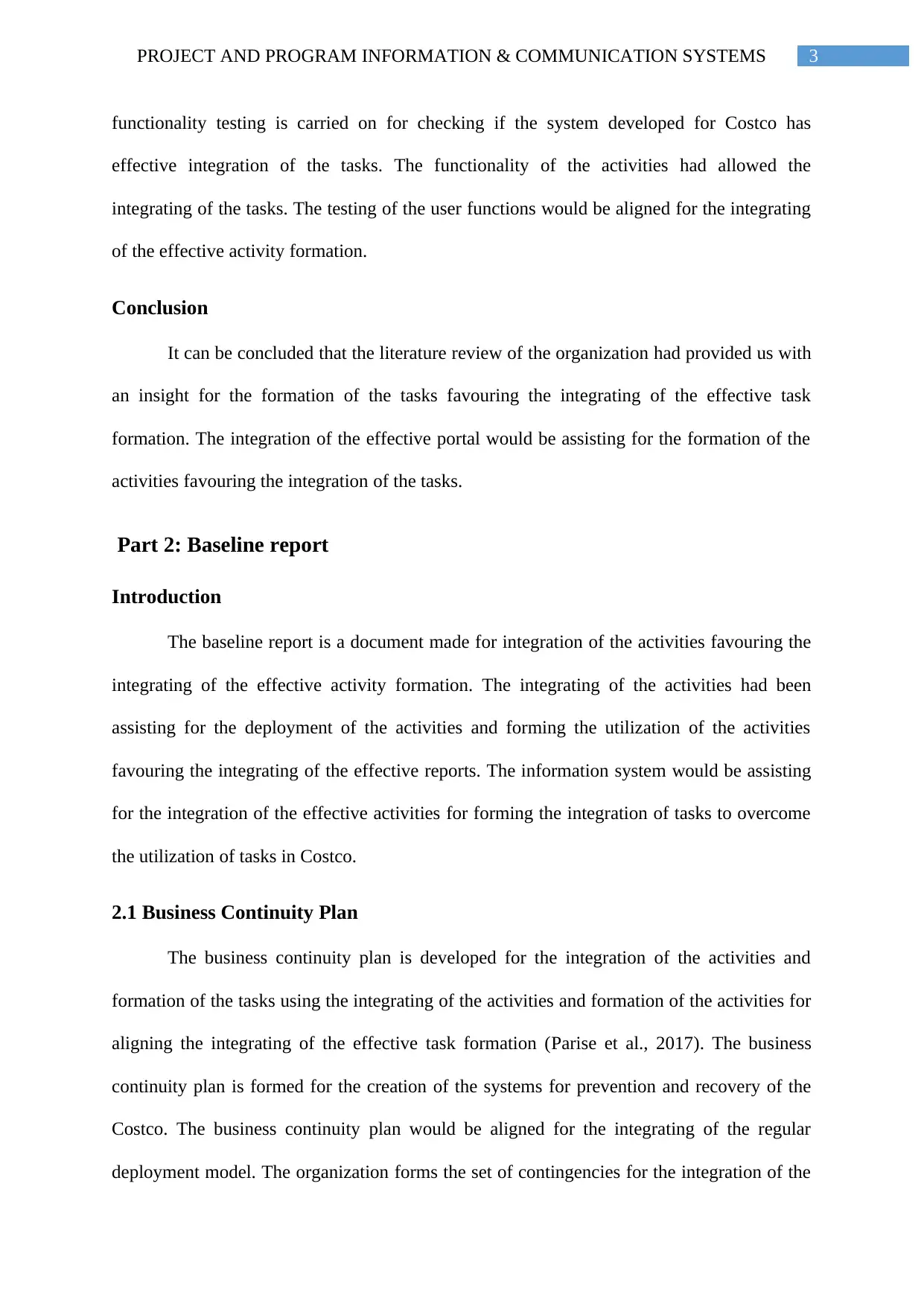
3PROJECT AND PROGRAM INFORMATION & COMMUNICATION SYSTEMS
functionality testing is carried on for checking if the system developed for Costco has
effective integration of the tasks. The functionality of the activities had allowed the
integrating of the tasks. The testing of the user functions would be aligned for the integrating
of the effective activity formation.
Conclusion
It can be concluded that the literature review of the organization had provided us with
an insight for the formation of the tasks favouring the integrating of the effective task
formation. The integration of the effective portal would be assisting for the formation of the
activities favouring the integration of the tasks.
Part 2: Baseline report
Introduction
The baseline report is a document made for integration of the activities favouring the
integrating of the effective activity formation. The integrating of the activities had been
assisting for the deployment of the activities and forming the utilization of the activities
favouring the integrating of the effective reports. The information system would be assisting
for the integration of the effective activities for forming the integration of tasks to overcome
the utilization of tasks in Costco.
2.1 Business Continuity Plan
The business continuity plan is developed for the integration of the activities and
formation of the tasks using the integrating of the activities and formation of the activities for
aligning the integrating of the effective task formation (Parise et al., 2017). The business
continuity plan is formed for the creation of the systems for prevention and recovery of the
Costco. The business continuity plan would be aligned for the integrating of the regular
deployment model. The organization forms the set of contingencies for the integration of the
functionality testing is carried on for checking if the system developed for Costco has
effective integration of the tasks. The functionality of the activities had allowed the
integrating of the tasks. The testing of the user functions would be aligned for the integrating
of the effective activity formation.
Conclusion
It can be concluded that the literature review of the organization had provided us with
an insight for the formation of the tasks favouring the integrating of the effective task
formation. The integration of the effective portal would be assisting for the formation of the
activities favouring the integration of the tasks.
Part 2: Baseline report
Introduction
The baseline report is a document made for integration of the activities favouring the
integrating of the effective activity formation. The integrating of the activities had been
assisting for the deployment of the activities and forming the utilization of the activities
favouring the integrating of the effective reports. The information system would be assisting
for the integration of the effective activities for forming the integration of tasks to overcome
the utilization of tasks in Costco.
2.1 Business Continuity Plan
The business continuity plan is developed for the integration of the activities and
formation of the tasks using the integrating of the activities and formation of the activities for
aligning the integrating of the effective task formation (Parise et al., 2017). The business
continuity plan is formed for the creation of the systems for prevention and recovery of the
Costco. The business continuity plan would be aligned for the integrating of the regular
deployment model. The organization forms the set of contingencies for the integration of the
Secure Best Marks with AI Grader
Need help grading? Try our AI Grader for instant feedback on your assignments.
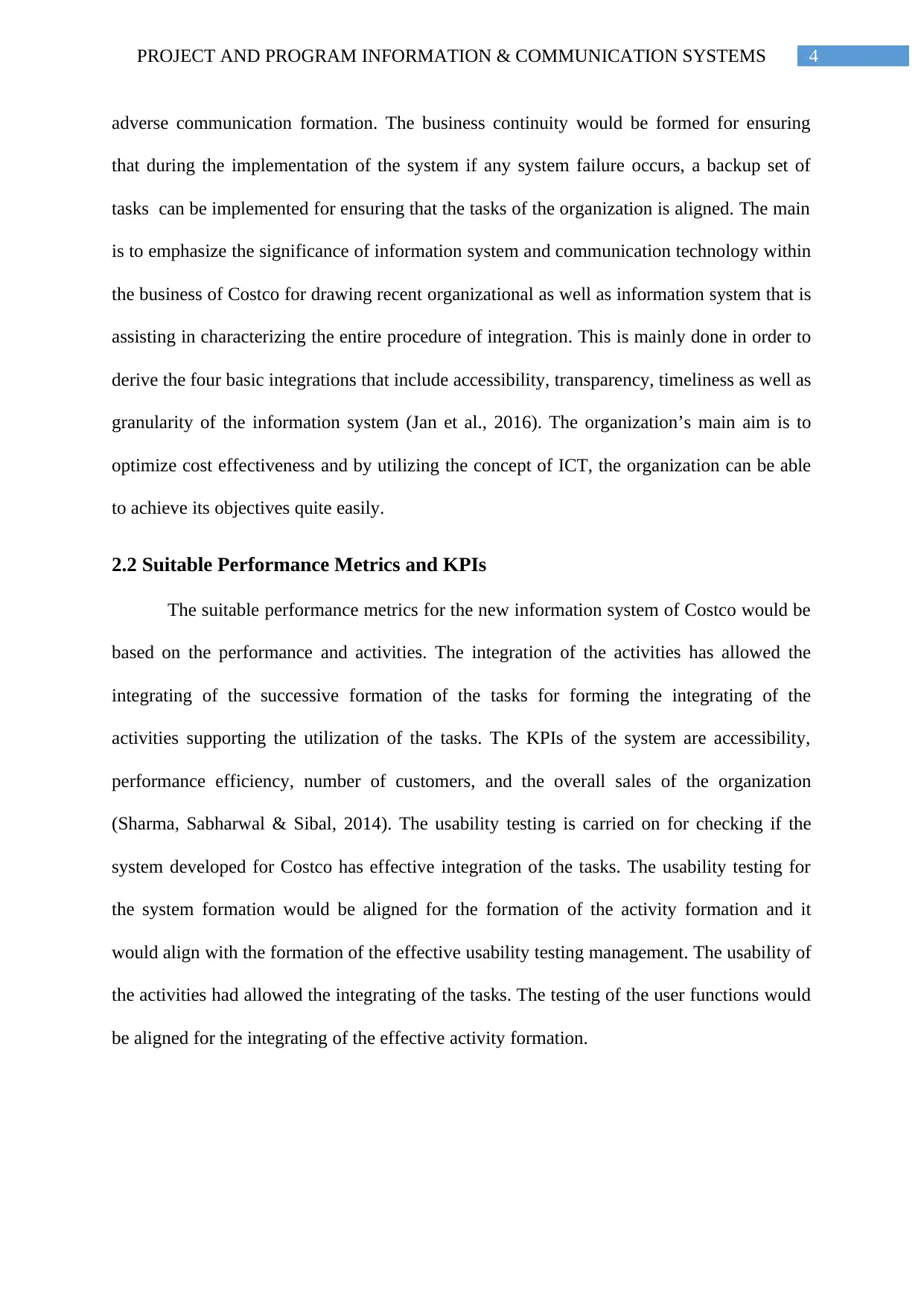
4PROJECT AND PROGRAM INFORMATION & COMMUNICATION SYSTEMS
adverse communication formation. The business continuity would be formed for ensuring
that during the implementation of the system if any system failure occurs, a backup set of
tasks can be implemented for ensuring that the tasks of the organization is aligned. The main
is to emphasize the significance of information system and communication technology within
the business of Costco for drawing recent organizational as well as information system that is
assisting in characterizing the entire procedure of integration. This is mainly done in order to
derive the four basic integrations that include accessibility, transparency, timeliness as well as
granularity of the information system (Jan et al., 2016). The organization’s main aim is to
optimize cost effectiveness and by utilizing the concept of ICT, the organization can be able
to achieve its objectives quite easily.
2.2 Suitable Performance Metrics and KPIs
The suitable performance metrics for the new information system of Costco would be
based on the performance and activities. The integration of the activities has allowed the
integrating of the successive formation of the tasks for forming the integrating of the
activities supporting the utilization of the tasks. The KPIs of the system are accessibility,
performance efficiency, number of customers, and the overall sales of the organization
(Sharma, Sabharwal & Sibal, 2014). The usability testing is carried on for checking if the
system developed for Costco has effective integration of the tasks. The usability testing for
the system formation would be aligned for the formation of the activity formation and it
would align with the formation of the effective usability testing management. The usability of
the activities had allowed the integrating of the tasks. The testing of the user functions would
be aligned for the integrating of the effective activity formation.
adverse communication formation. The business continuity would be formed for ensuring
that during the implementation of the system if any system failure occurs, a backup set of
tasks can be implemented for ensuring that the tasks of the organization is aligned. The main
is to emphasize the significance of information system and communication technology within
the business of Costco for drawing recent organizational as well as information system that is
assisting in characterizing the entire procedure of integration. This is mainly done in order to
derive the four basic integrations that include accessibility, transparency, timeliness as well as
granularity of the information system (Jan et al., 2016). The organization’s main aim is to
optimize cost effectiveness and by utilizing the concept of ICT, the organization can be able
to achieve its objectives quite easily.
2.2 Suitable Performance Metrics and KPIs
The suitable performance metrics for the new information system of Costco would be
based on the performance and activities. The integration of the activities has allowed the
integrating of the successive formation of the tasks for forming the integrating of the
activities supporting the utilization of the tasks. The KPIs of the system are accessibility,
performance efficiency, number of customers, and the overall sales of the organization
(Sharma, Sabharwal & Sibal, 2014). The usability testing is carried on for checking if the
system developed for Costco has effective integration of the tasks. The usability testing for
the system formation would be aligned for the formation of the activity formation and it
would align with the formation of the effective usability testing management. The usability of
the activities had allowed the integrating of the tasks. The testing of the user functions would
be aligned for the integrating of the effective activity formation.
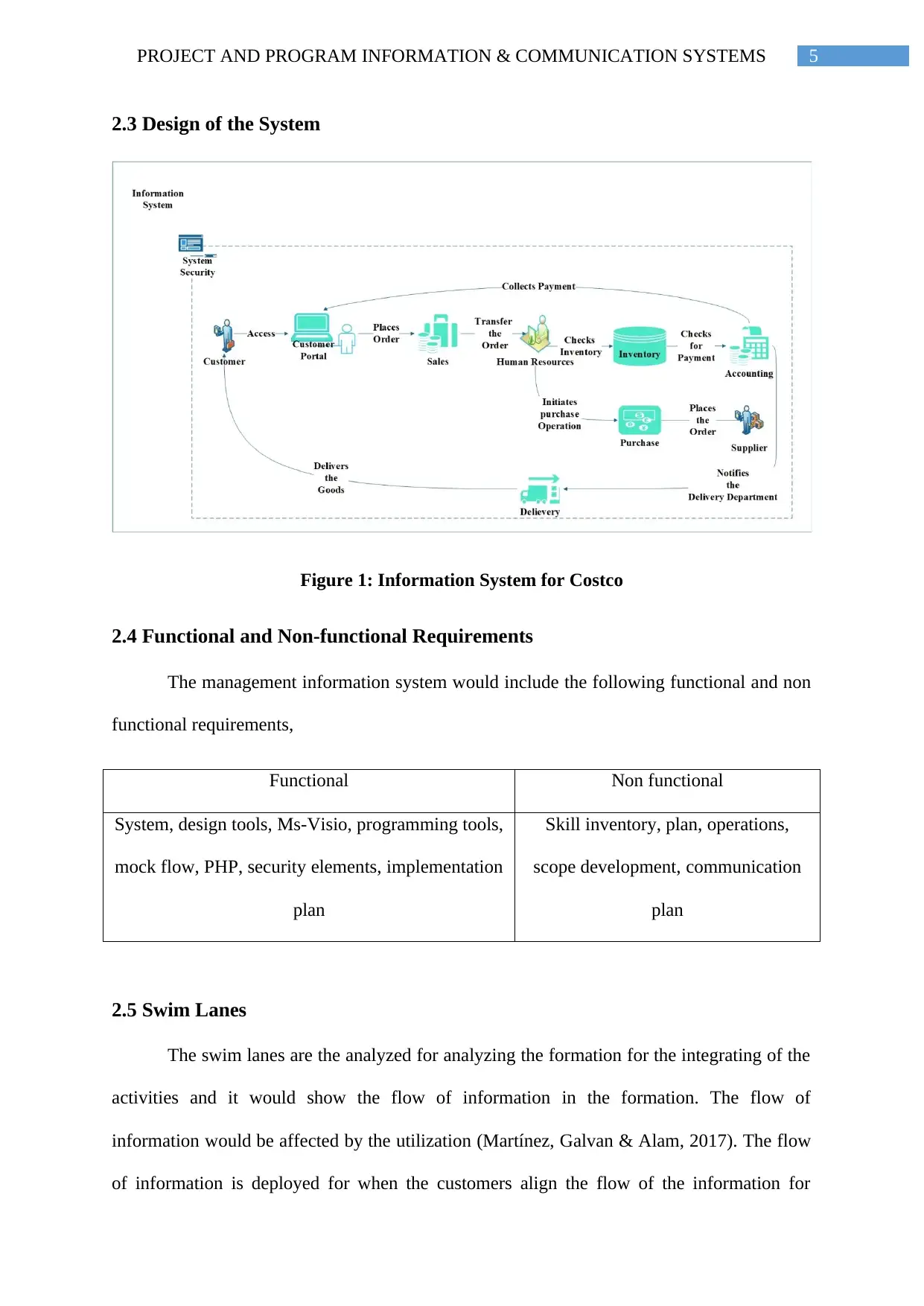
5PROJECT AND PROGRAM INFORMATION & COMMUNICATION SYSTEMS
2.3 Design of the System
Figure 1: Information System for Costco
2.4 Functional and Non-functional Requirements
The management information system would include the following functional and non
functional requirements,
Functional Non functional
System, design tools, Ms-Visio, programming tools,
mock flow, PHP, security elements, implementation
plan
Skill inventory, plan, operations,
scope development, communication
plan
2.5 Swim Lanes
The swim lanes are the analyzed for analyzing the formation for the integrating of the
activities and it would show the flow of information in the formation. The flow of
information would be affected by the utilization (Martínez, Galvan & Alam, 2017). The flow
of information is deployed for when the customers align the flow of the information for
2.3 Design of the System
Figure 1: Information System for Costco
2.4 Functional and Non-functional Requirements
The management information system would include the following functional and non
functional requirements,
Functional Non functional
System, design tools, Ms-Visio, programming tools,
mock flow, PHP, security elements, implementation
plan
Skill inventory, plan, operations,
scope development, communication
plan
2.5 Swim Lanes
The swim lanes are the analyzed for analyzing the formation for the integrating of the
activities and it would show the flow of information in the formation. The flow of
information would be affected by the utilization (Martínez, Galvan & Alam, 2017). The flow
of information is deployed for when the customers align the flow of the information for
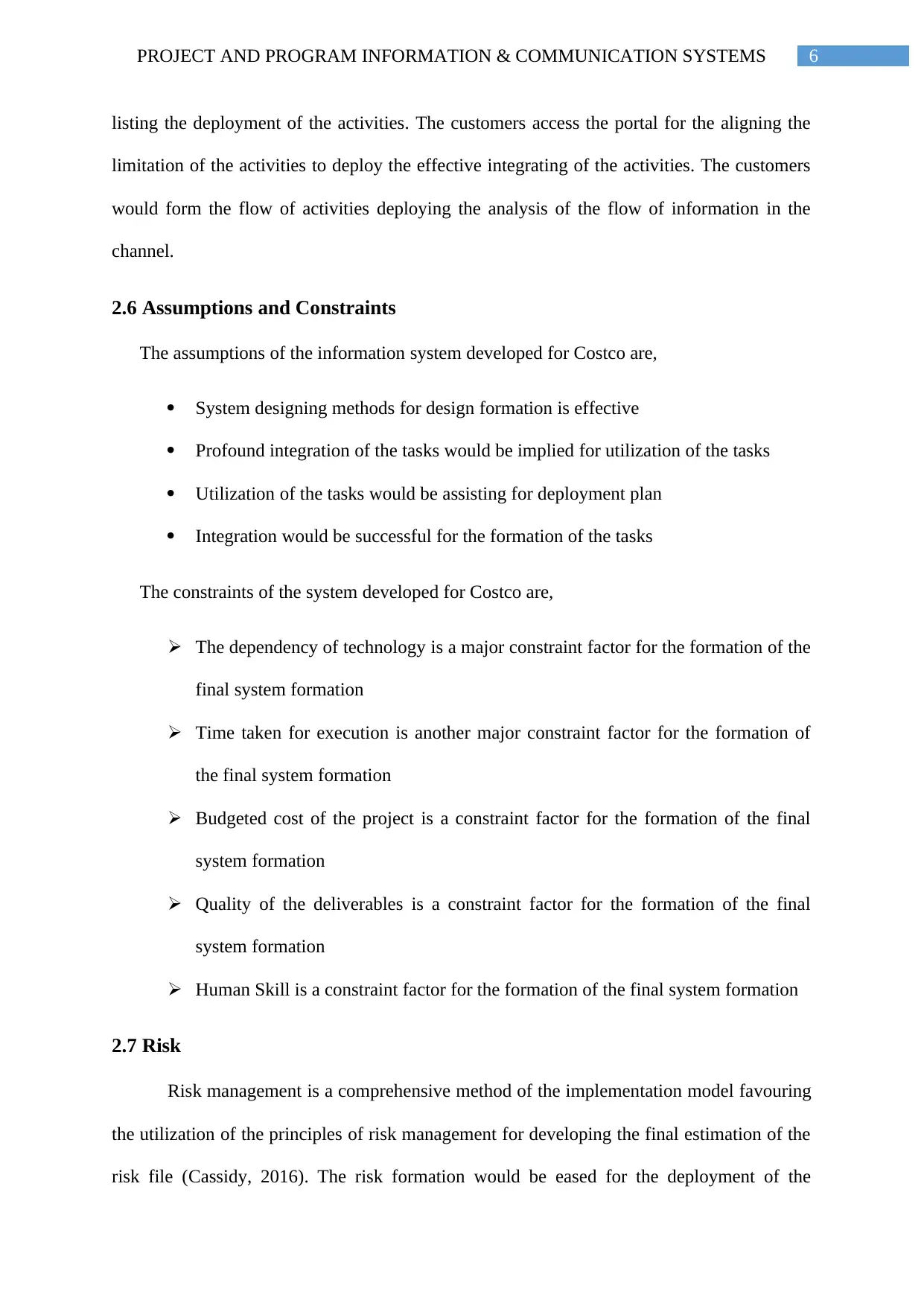
6PROJECT AND PROGRAM INFORMATION & COMMUNICATION SYSTEMS
listing the deployment of the activities. The customers access the portal for the aligning the
limitation of the activities to deploy the effective integrating of the activities. The customers
would form the flow of activities deploying the analysis of the flow of information in the
channel.
2.6 Assumptions and Constraints
The assumptions of the information system developed for Costco are,
System designing methods for design formation is effective
Profound integration of the tasks would be implied for utilization of the tasks
Utilization of the tasks would be assisting for deployment plan
Integration would be successful for the formation of the tasks
The constraints of the system developed for Costco are,
The dependency of technology is a major constraint factor for the formation of the
final system formation
Time taken for execution is another major constraint factor for the formation of
the final system formation
Budgeted cost of the project is a constraint factor for the formation of the final
system formation
Quality of the deliverables is a constraint factor for the formation of the final
system formation
Human Skill is a constraint factor for the formation of the final system formation
2.7 Risk
Risk management is a comprehensive method of the implementation model favouring
the utilization of the principles of risk management for developing the final estimation of the
risk file (Cassidy, 2016). The risk formation would be eased for the deployment of the
listing the deployment of the activities. The customers access the portal for the aligning the
limitation of the activities to deploy the effective integrating of the activities. The customers
would form the flow of activities deploying the analysis of the flow of information in the
channel.
2.6 Assumptions and Constraints
The assumptions of the information system developed for Costco are,
System designing methods for design formation is effective
Profound integration of the tasks would be implied for utilization of the tasks
Utilization of the tasks would be assisting for deployment plan
Integration would be successful for the formation of the tasks
The constraints of the system developed for Costco are,
The dependency of technology is a major constraint factor for the formation of the
final system formation
Time taken for execution is another major constraint factor for the formation of
the final system formation
Budgeted cost of the project is a constraint factor for the formation of the final
system formation
Quality of the deliverables is a constraint factor for the formation of the final
system formation
Human Skill is a constraint factor for the formation of the final system formation
2.7 Risk
Risk management is a comprehensive method of the implementation model favouring
the utilization of the principles of risk management for developing the final estimation of the
risk file (Cassidy, 2016). The risk formation would be eased for the deployment of the
Paraphrase This Document
Need a fresh take? Get an instant paraphrase of this document with our AI Paraphraser
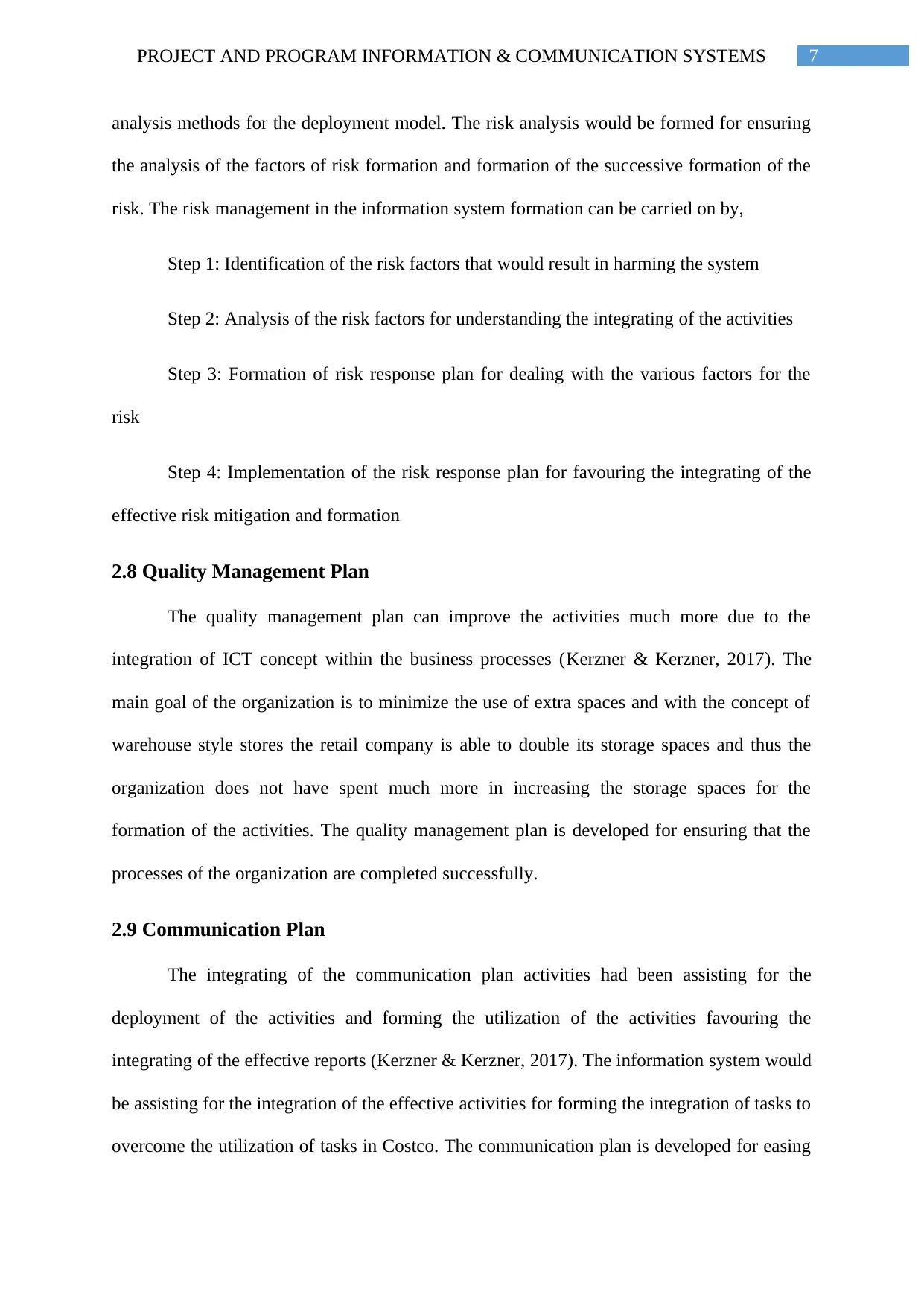
7PROJECT AND PROGRAM INFORMATION & COMMUNICATION SYSTEMS
analysis methods for the deployment model. The risk analysis would be formed for ensuring
the analysis of the factors of risk formation and formation of the successive formation of the
risk. The risk management in the information system formation can be carried on by,
Step 1: Identification of the risk factors that would result in harming the system
Step 2: Analysis of the risk factors for understanding the integrating of the activities
Step 3: Formation of risk response plan for dealing with the various factors for the
risk
Step 4: Implementation of the risk response plan for favouring the integrating of the
effective risk mitigation and formation
2.8 Quality Management Plan
The quality management plan can improve the activities much more due to the
integration of ICT concept within the business processes (Kerzner & Kerzner, 2017). The
main goal of the organization is to minimize the use of extra spaces and with the concept of
warehouse style stores the retail company is able to double its storage spaces and thus the
organization does not have spent much more in increasing the storage spaces for the
formation of the activities. The quality management plan is developed for ensuring that the
processes of the organization are completed successfully.
2.9 Communication Plan
The integrating of the communication plan activities had been assisting for the
deployment of the activities and forming the utilization of the activities favouring the
integrating of the effective reports (Kerzner & Kerzner, 2017). The information system would
be assisting for the integration of the effective activities for forming the integration of tasks to
overcome the utilization of tasks in Costco. The communication plan is developed for easing
analysis methods for the deployment model. The risk analysis would be formed for ensuring
the analysis of the factors of risk formation and formation of the successive formation of the
risk. The risk management in the information system formation can be carried on by,
Step 1: Identification of the risk factors that would result in harming the system
Step 2: Analysis of the risk factors for understanding the integrating of the activities
Step 3: Formation of risk response plan for dealing with the various factors for the
risk
Step 4: Implementation of the risk response plan for favouring the integrating of the
effective risk mitigation and formation
2.8 Quality Management Plan
The quality management plan can improve the activities much more due to the
integration of ICT concept within the business processes (Kerzner & Kerzner, 2017). The
main goal of the organization is to minimize the use of extra spaces and with the concept of
warehouse style stores the retail company is able to double its storage spaces and thus the
organization does not have spent much more in increasing the storage spaces for the
formation of the activities. The quality management plan is developed for ensuring that the
processes of the organization are completed successfully.
2.9 Communication Plan
The integrating of the communication plan activities had been assisting for the
deployment of the activities and forming the utilization of the activities favouring the
integrating of the effective reports (Kerzner & Kerzner, 2017). The information system would
be assisting for the integration of the effective activities for forming the integration of tasks to
overcome the utilization of tasks in Costco. The communication plan is developed for easing
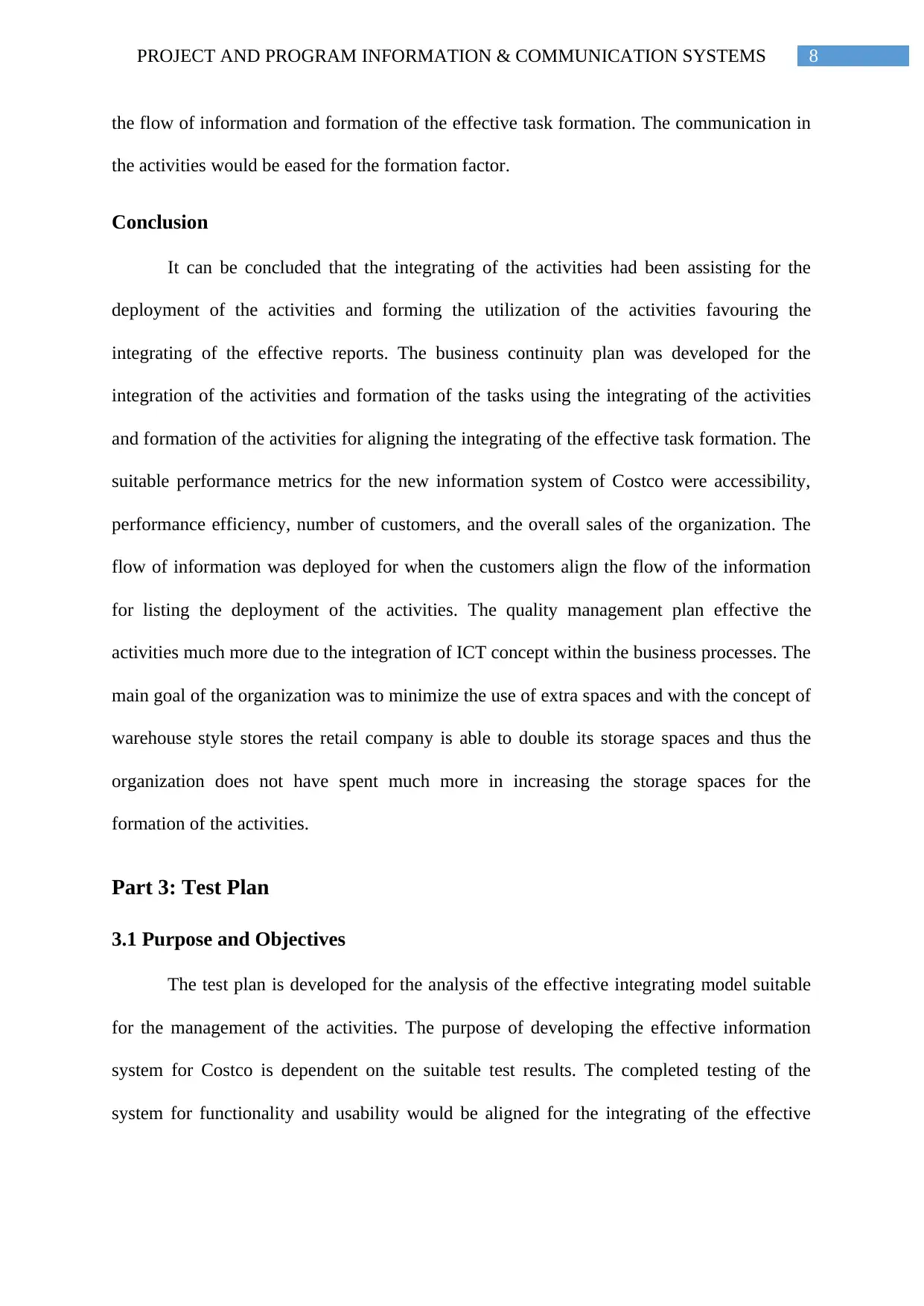
8PROJECT AND PROGRAM INFORMATION & COMMUNICATION SYSTEMS
the flow of information and formation of the effective task formation. The communication in
the activities would be eased for the formation factor.
Conclusion
It can be concluded that the integrating of the activities had been assisting for the
deployment of the activities and forming the utilization of the activities favouring the
integrating of the effective reports. The business continuity plan was developed for the
integration of the activities and formation of the tasks using the integrating of the activities
and formation of the activities for aligning the integrating of the effective task formation. The
suitable performance metrics for the new information system of Costco were accessibility,
performance efficiency, number of customers, and the overall sales of the organization. The
flow of information was deployed for when the customers align the flow of the information
for listing the deployment of the activities. The quality management plan effective the
activities much more due to the integration of ICT concept within the business processes. The
main goal of the organization was to minimize the use of extra spaces and with the concept of
warehouse style stores the retail company is able to double its storage spaces and thus the
organization does not have spent much more in increasing the storage spaces for the
formation of the activities.
Part 3: Test Plan
3.1 Purpose and Objectives
The test plan is developed for the analysis of the effective integrating model suitable
for the management of the activities. The purpose of developing the effective information
system for Costco is dependent on the suitable test results. The completed testing of the
system for functionality and usability would be aligned for the integrating of the effective
the flow of information and formation of the effective task formation. The communication in
the activities would be eased for the formation factor.
Conclusion
It can be concluded that the integrating of the activities had been assisting for the
deployment of the activities and forming the utilization of the activities favouring the
integrating of the effective reports. The business continuity plan was developed for the
integration of the activities and formation of the tasks using the integrating of the activities
and formation of the activities for aligning the integrating of the effective task formation. The
suitable performance metrics for the new information system of Costco were accessibility,
performance efficiency, number of customers, and the overall sales of the organization. The
flow of information was deployed for when the customers align the flow of the information
for listing the deployment of the activities. The quality management plan effective the
activities much more due to the integration of ICT concept within the business processes. The
main goal of the organization was to minimize the use of extra spaces and with the concept of
warehouse style stores the retail company is able to double its storage spaces and thus the
organization does not have spent much more in increasing the storage spaces for the
formation of the activities.
Part 3: Test Plan
3.1 Purpose and Objectives
The test plan is developed for the analysis of the effective integrating model suitable
for the management of the activities. The purpose of developing the effective information
system for Costco is dependent on the suitable test results. The completed testing of the
system for functionality and usability would be aligned for the integrating of the effective
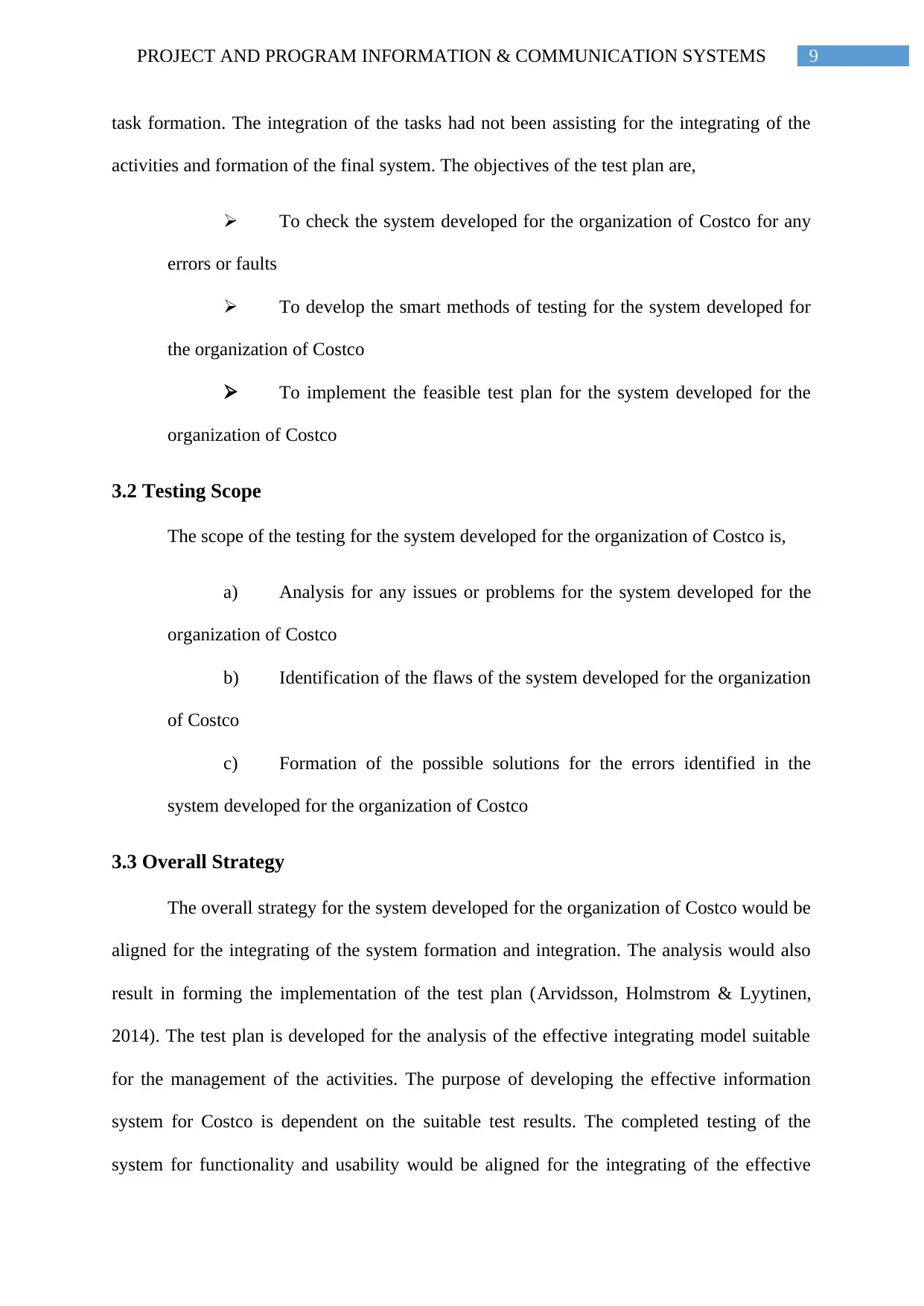
9PROJECT AND PROGRAM INFORMATION & COMMUNICATION SYSTEMS
task formation. The integration of the tasks had not been assisting for the integrating of the
activities and formation of the final system. The objectives of the test plan are,
To check the system developed for the organization of Costco for any
errors or faults
To develop the smart methods of testing for the system developed for
the organization of Costco
To implement the feasible test plan for the system developed for the
organization of Costco
3.2 Testing Scope
The scope of the testing for the system developed for the organization of Costco is,
a) Analysis for any issues or problems for the system developed for the
organization of Costco
b) Identification of the flaws of the system developed for the organization
of Costco
c) Formation of the possible solutions for the errors identified in the
system developed for the organization of Costco
3.3 Overall Strategy
The overall strategy for the system developed for the organization of Costco would be
aligned for the integrating of the system formation and integration. The analysis would also
result in forming the implementation of the test plan (Arvidsson, Holmstrom & Lyytinen,
2014). The test plan is developed for the analysis of the effective integrating model suitable
for the management of the activities. The purpose of developing the effective information
system for Costco is dependent on the suitable test results. The completed testing of the
system for functionality and usability would be aligned for the integrating of the effective
task formation. The integration of the tasks had not been assisting for the integrating of the
activities and formation of the final system. The objectives of the test plan are,
To check the system developed for the organization of Costco for any
errors or faults
To develop the smart methods of testing for the system developed for
the organization of Costco
To implement the feasible test plan for the system developed for the
organization of Costco
3.2 Testing Scope
The scope of the testing for the system developed for the organization of Costco is,
a) Analysis for any issues or problems for the system developed for the
organization of Costco
b) Identification of the flaws of the system developed for the organization
of Costco
c) Formation of the possible solutions for the errors identified in the
system developed for the organization of Costco
3.3 Overall Strategy
The overall strategy for the system developed for the organization of Costco would be
aligned for the integrating of the system formation and integration. The analysis would also
result in forming the implementation of the test plan (Arvidsson, Holmstrom & Lyytinen,
2014). The test plan is developed for the analysis of the effective integrating model suitable
for the management of the activities. The purpose of developing the effective information
system for Costco is dependent on the suitable test results. The completed testing of the
system for functionality and usability would be aligned for the integrating of the effective
Secure Best Marks with AI Grader
Need help grading? Try our AI Grader for instant feedback on your assignments.
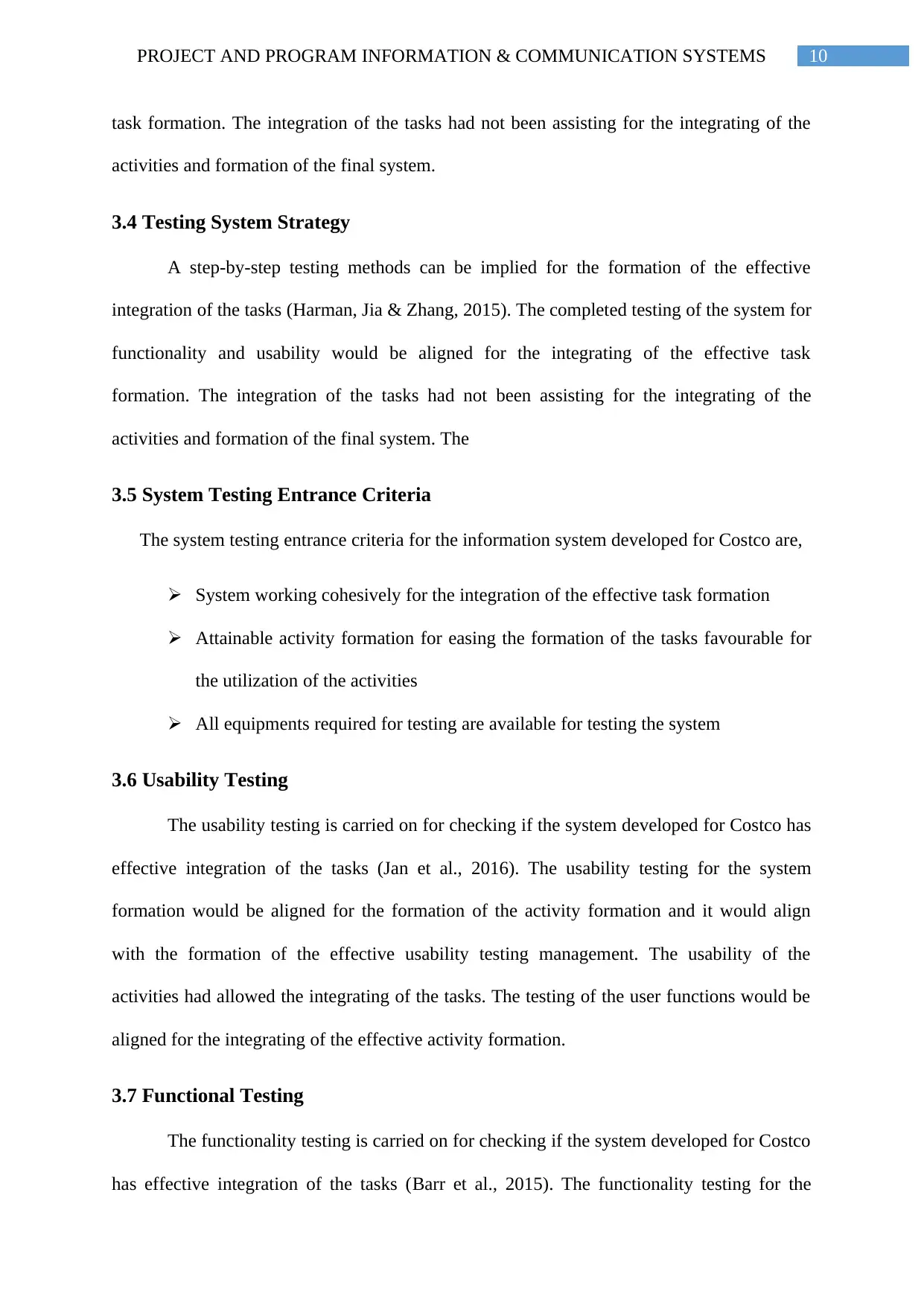
10PROJECT AND PROGRAM INFORMATION & COMMUNICATION SYSTEMS
task formation. The integration of the tasks had not been assisting for the integrating of the
activities and formation of the final system.
3.4 Testing System Strategy
A step-by-step testing methods can be implied for the formation of the effective
integration of the tasks (Harman, Jia & Zhang, 2015). The completed testing of the system for
functionality and usability would be aligned for the integrating of the effective task
formation. The integration of the tasks had not been assisting for the integrating of the
activities and formation of the final system. The
3.5 System Testing Entrance Criteria
The system testing entrance criteria for the information system developed for Costco are,
System working cohesively for the integration of the effective task formation
Attainable activity formation for easing the formation of the tasks favourable for
the utilization of the activities
All equipments required for testing are available for testing the system
3.6 Usability Testing
The usability testing is carried on for checking if the system developed for Costco has
effective integration of the tasks (Jan et al., 2016). The usability testing for the system
formation would be aligned for the formation of the activity formation and it would align
with the formation of the effective usability testing management. The usability of the
activities had allowed the integrating of the tasks. The testing of the user functions would be
aligned for the integrating of the effective activity formation.
3.7 Functional Testing
The functionality testing is carried on for checking if the system developed for Costco
has effective integration of the tasks (Barr et al., 2015). The functionality testing for the
task formation. The integration of the tasks had not been assisting for the integrating of the
activities and formation of the final system.
3.4 Testing System Strategy
A step-by-step testing methods can be implied for the formation of the effective
integration of the tasks (Harman, Jia & Zhang, 2015). The completed testing of the system for
functionality and usability would be aligned for the integrating of the effective task
formation. The integration of the tasks had not been assisting for the integrating of the
activities and formation of the final system. The
3.5 System Testing Entrance Criteria
The system testing entrance criteria for the information system developed for Costco are,
System working cohesively for the integration of the effective task formation
Attainable activity formation for easing the formation of the tasks favourable for
the utilization of the activities
All equipments required for testing are available for testing the system
3.6 Usability Testing
The usability testing is carried on for checking if the system developed for Costco has
effective integration of the tasks (Jan et al., 2016). The usability testing for the system
formation would be aligned for the formation of the activity formation and it would align
with the formation of the effective usability testing management. The usability of the
activities had allowed the integrating of the tasks. The testing of the user functions would be
aligned for the integrating of the effective activity formation.
3.7 Functional Testing
The functionality testing is carried on for checking if the system developed for Costco
has effective integration of the tasks (Barr et al., 2015). The functionality testing for the
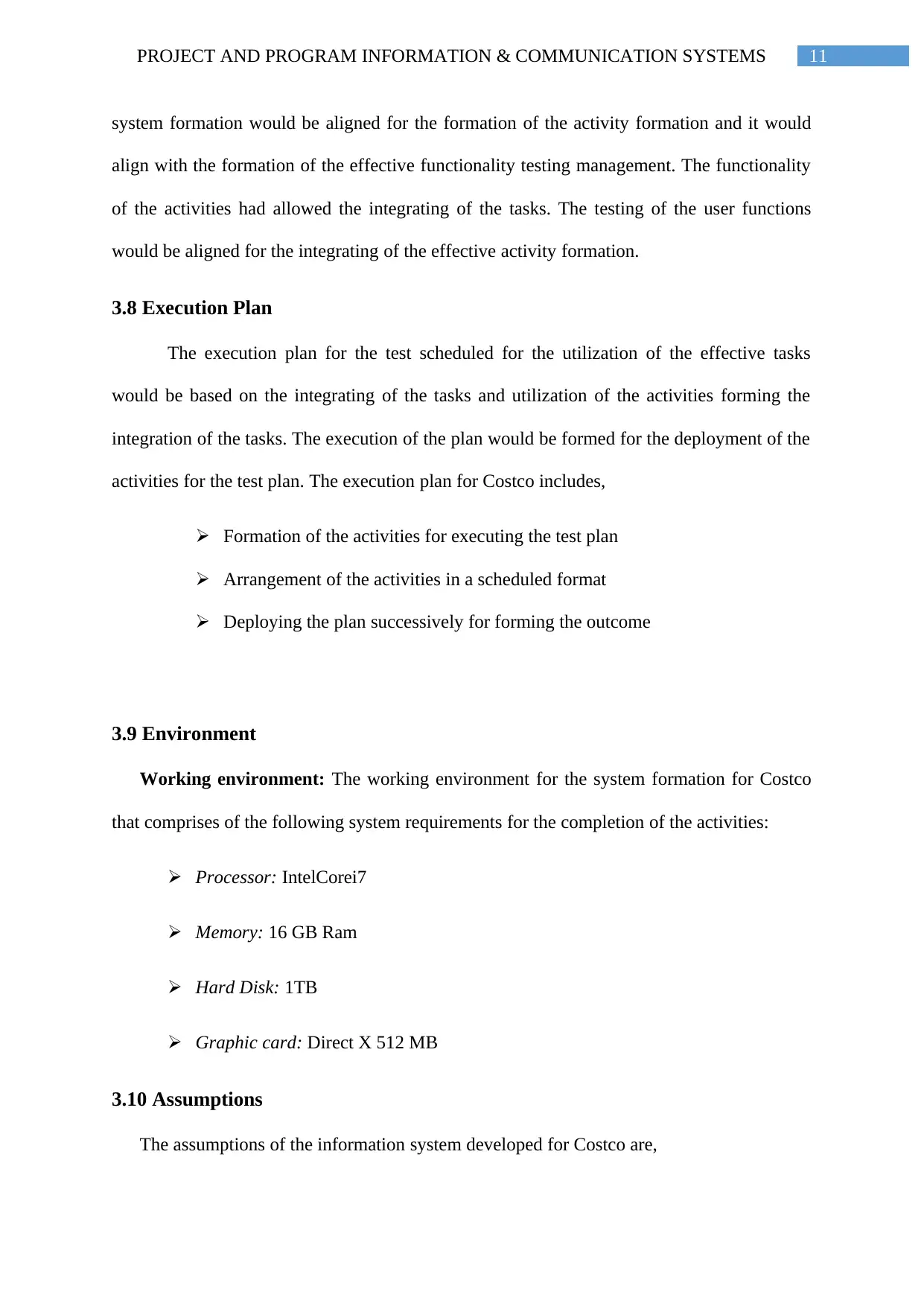
11PROJECT AND PROGRAM INFORMATION & COMMUNICATION SYSTEMS
system formation would be aligned for the formation of the activity formation and it would
align with the formation of the effective functionality testing management. The functionality
of the activities had allowed the integrating of the tasks. The testing of the user functions
would be aligned for the integrating of the effective activity formation.
3.8 Execution Plan
The execution plan for the test scheduled for the utilization of the effective tasks
would be based on the integrating of the tasks and utilization of the activities forming the
integration of the tasks. The execution of the plan would be formed for the deployment of the
activities for the test plan. The execution plan for Costco includes,
Formation of the activities for executing the test plan
Arrangement of the activities in a scheduled format
Deploying the plan successively for forming the outcome
3.9 Environment
Working environment: The working environment for the system formation for Costco
that comprises of the following system requirements for the completion of the activities:
Processor: IntelCorei7
Memory: 16 GB Ram
Hard Disk: 1TB
Graphic card: Direct X 512 MB
3.10 Assumptions
The assumptions of the information system developed for Costco are,
system formation would be aligned for the formation of the activity formation and it would
align with the formation of the effective functionality testing management. The functionality
of the activities had allowed the integrating of the tasks. The testing of the user functions
would be aligned for the integrating of the effective activity formation.
3.8 Execution Plan
The execution plan for the test scheduled for the utilization of the effective tasks
would be based on the integrating of the tasks and utilization of the activities forming the
integration of the tasks. The execution of the plan would be formed for the deployment of the
activities for the test plan. The execution plan for Costco includes,
Formation of the activities for executing the test plan
Arrangement of the activities in a scheduled format
Deploying the plan successively for forming the outcome
3.9 Environment
Working environment: The working environment for the system formation for Costco
that comprises of the following system requirements for the completion of the activities:
Processor: IntelCorei7
Memory: 16 GB Ram
Hard Disk: 1TB
Graphic card: Direct X 512 MB
3.10 Assumptions
The assumptions of the information system developed for Costco are,
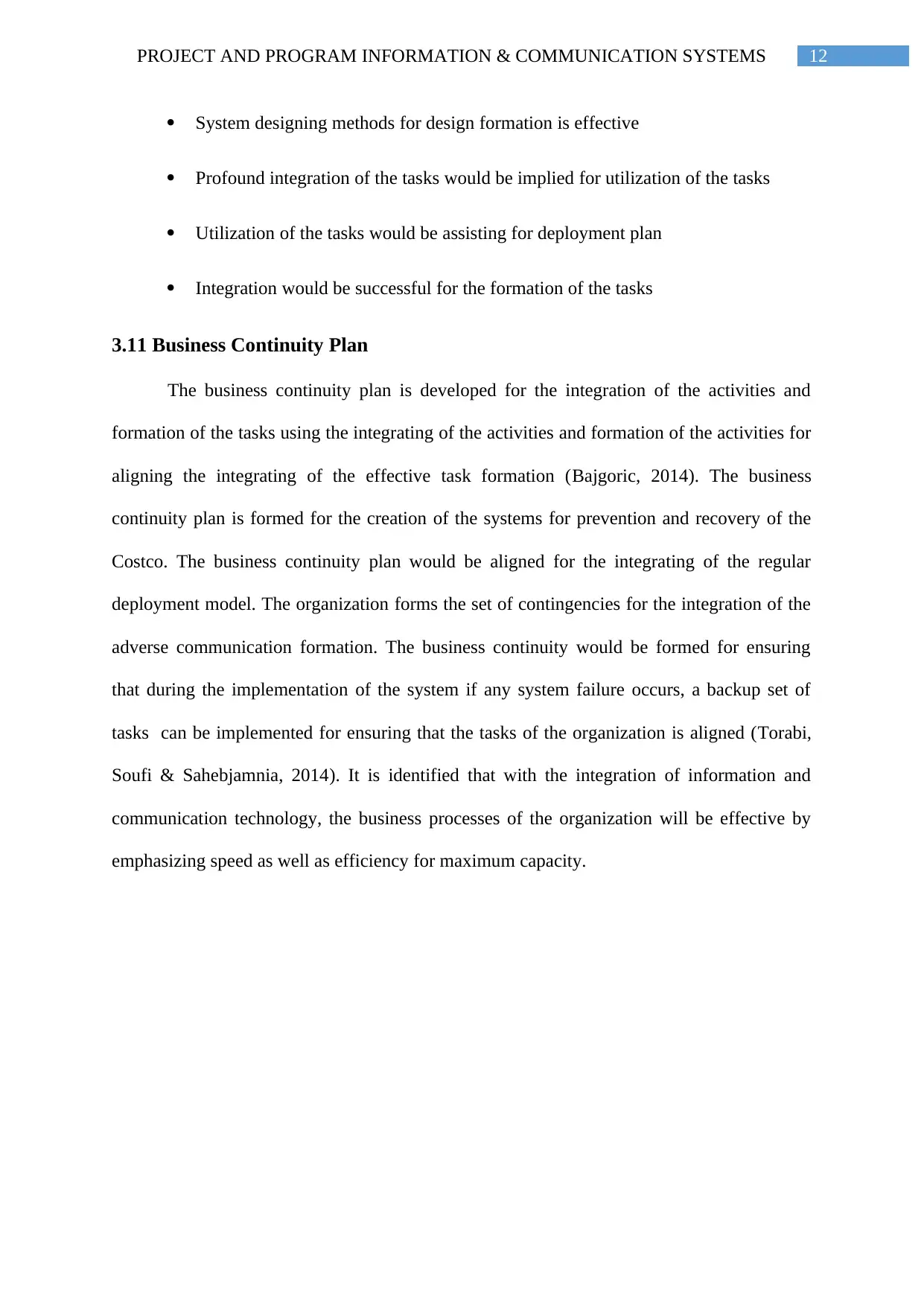
12PROJECT AND PROGRAM INFORMATION & COMMUNICATION SYSTEMS
System designing methods for design formation is effective
Profound integration of the tasks would be implied for utilization of the tasks
Utilization of the tasks would be assisting for deployment plan
Integration would be successful for the formation of the tasks
3.11 Business Continuity Plan
The business continuity plan is developed for the integration of the activities and
formation of the tasks using the integrating of the activities and formation of the activities for
aligning the integrating of the effective task formation (Bajgoric, 2014). The business
continuity plan is formed for the creation of the systems for prevention and recovery of the
Costco. The business continuity plan would be aligned for the integrating of the regular
deployment model. The organization forms the set of contingencies for the integration of the
adverse communication formation. The business continuity would be formed for ensuring
that during the implementation of the system if any system failure occurs, a backup set of
tasks can be implemented for ensuring that the tasks of the organization is aligned (Torabi,
Soufi & Sahebjamnia, 2014). It is identified that with the integration of information and
communication technology, the business processes of the organization will be effective by
emphasizing speed as well as efficiency for maximum capacity.
System designing methods for design formation is effective
Profound integration of the tasks would be implied for utilization of the tasks
Utilization of the tasks would be assisting for deployment plan
Integration would be successful for the formation of the tasks
3.11 Business Continuity Plan
The business continuity plan is developed for the integration of the activities and
formation of the tasks using the integrating of the activities and formation of the activities for
aligning the integrating of the effective task formation (Bajgoric, 2014). The business
continuity plan is formed for the creation of the systems for prevention and recovery of the
Costco. The business continuity plan would be aligned for the integrating of the regular
deployment model. The organization forms the set of contingencies for the integration of the
adverse communication formation. The business continuity would be formed for ensuring
that during the implementation of the system if any system failure occurs, a backup set of
tasks can be implemented for ensuring that the tasks of the organization is aligned (Torabi,
Soufi & Sahebjamnia, 2014). It is identified that with the integration of information and
communication technology, the business processes of the organization will be effective by
emphasizing speed as well as efficiency for maximum capacity.
Paraphrase This Document
Need a fresh take? Get an instant paraphrase of this document with our AI Paraphraser
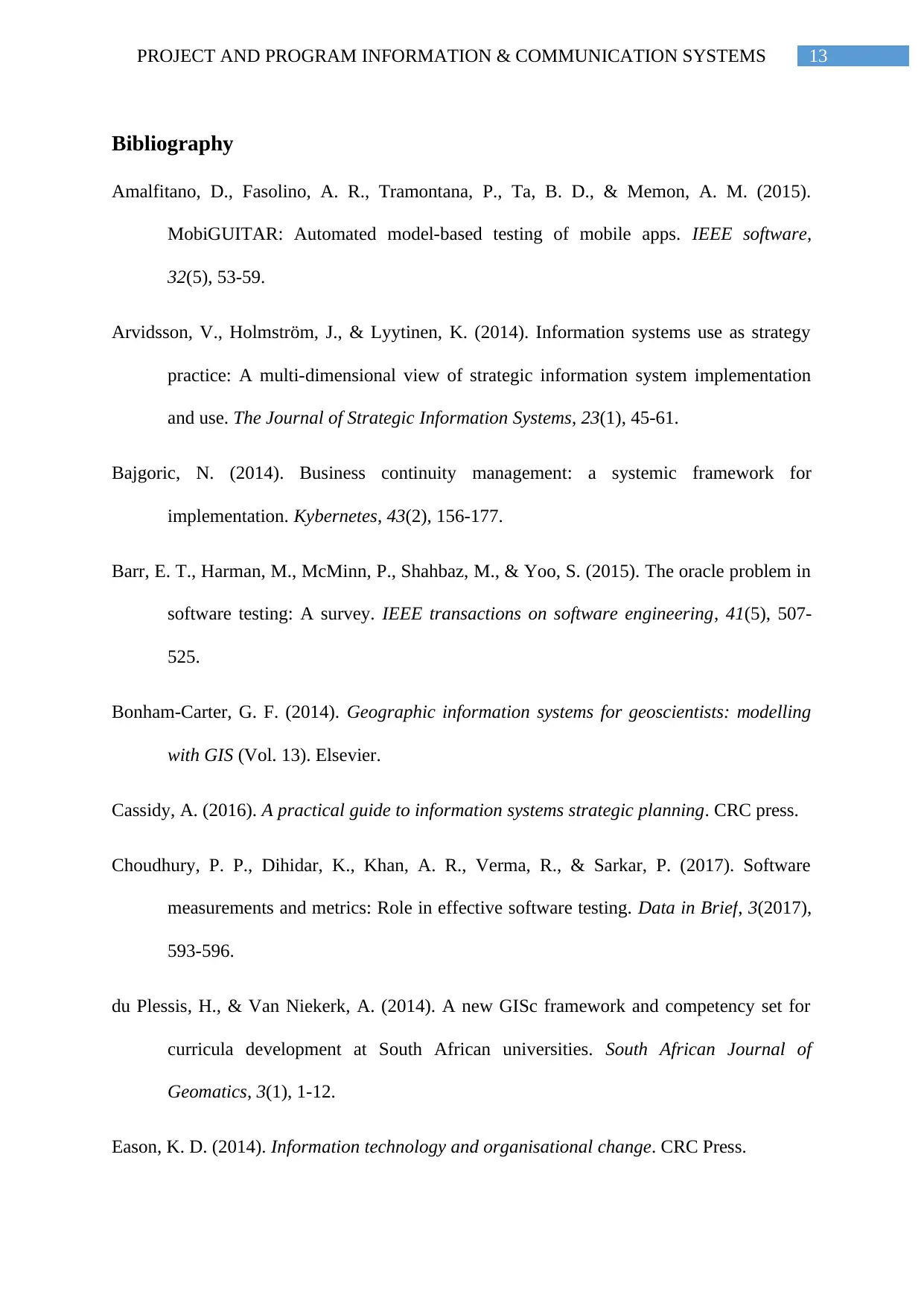
13PROJECT AND PROGRAM INFORMATION & COMMUNICATION SYSTEMS
Bibliography
Amalfitano, D., Fasolino, A. R., Tramontana, P., Ta, B. D., & Memon, A. M. (2015).
MobiGUITAR: Automated model-based testing of mobile apps. IEEE software,
32(5), 53-59.
Arvidsson, V., Holmström, J., & Lyytinen, K. (2014). Information systems use as strategy
practice: A multi-dimensional view of strategic information system implementation
and use. The Journal of Strategic Information Systems, 23(1), 45-61.
Bajgoric, N. (2014). Business continuity management: a systemic framework for
implementation. Kybernetes, 43(2), 156-177.
Barr, E. T., Harman, M., McMinn, P., Shahbaz, M., & Yoo, S. (2015). The oracle problem in
software testing: A survey. IEEE transactions on software engineering, 41(5), 507-
525.
Bonham-Carter, G. F. (2014). Geographic information systems for geoscientists: modelling
with GIS (Vol. 13). Elsevier.
Cassidy, A. (2016). A practical guide to information systems strategic planning. CRC press.
Choudhury, P. P., Dihidar, K., Khan, A. R., Verma, R., & Sarkar, P. (2017). Software
measurements and metrics: Role in effective software testing. Data in Brief, 3(2017),
593-596.
du Plessis, H., & Van Niekerk, A. (2014). A new GISc framework and competency set for
curricula development at South African universities. South African Journal of
Geomatics, 3(1), 1-12.
Eason, K. D. (2014). Information technology and organisational change. CRC Press.
Bibliography
Amalfitano, D., Fasolino, A. R., Tramontana, P., Ta, B. D., & Memon, A. M. (2015).
MobiGUITAR: Automated model-based testing of mobile apps. IEEE software,
32(5), 53-59.
Arvidsson, V., Holmström, J., & Lyytinen, K. (2014). Information systems use as strategy
practice: A multi-dimensional view of strategic information system implementation
and use. The Journal of Strategic Information Systems, 23(1), 45-61.
Bajgoric, N. (2014). Business continuity management: a systemic framework for
implementation. Kybernetes, 43(2), 156-177.
Barr, E. T., Harman, M., McMinn, P., Shahbaz, M., & Yoo, S. (2015). The oracle problem in
software testing: A survey. IEEE transactions on software engineering, 41(5), 507-
525.
Bonham-Carter, G. F. (2014). Geographic information systems for geoscientists: modelling
with GIS (Vol. 13). Elsevier.
Cassidy, A. (2016). A practical guide to information systems strategic planning. CRC press.
Choudhury, P. P., Dihidar, K., Khan, A. R., Verma, R., & Sarkar, P. (2017). Software
measurements and metrics: Role in effective software testing. Data in Brief, 3(2017),
593-596.
du Plessis, H., & Van Niekerk, A. (2014). A new GISc framework and competency set for
curricula development at South African universities. South African Journal of
Geomatics, 3(1), 1-12.
Eason, K. D. (2014). Information technology and organisational change. CRC Press.
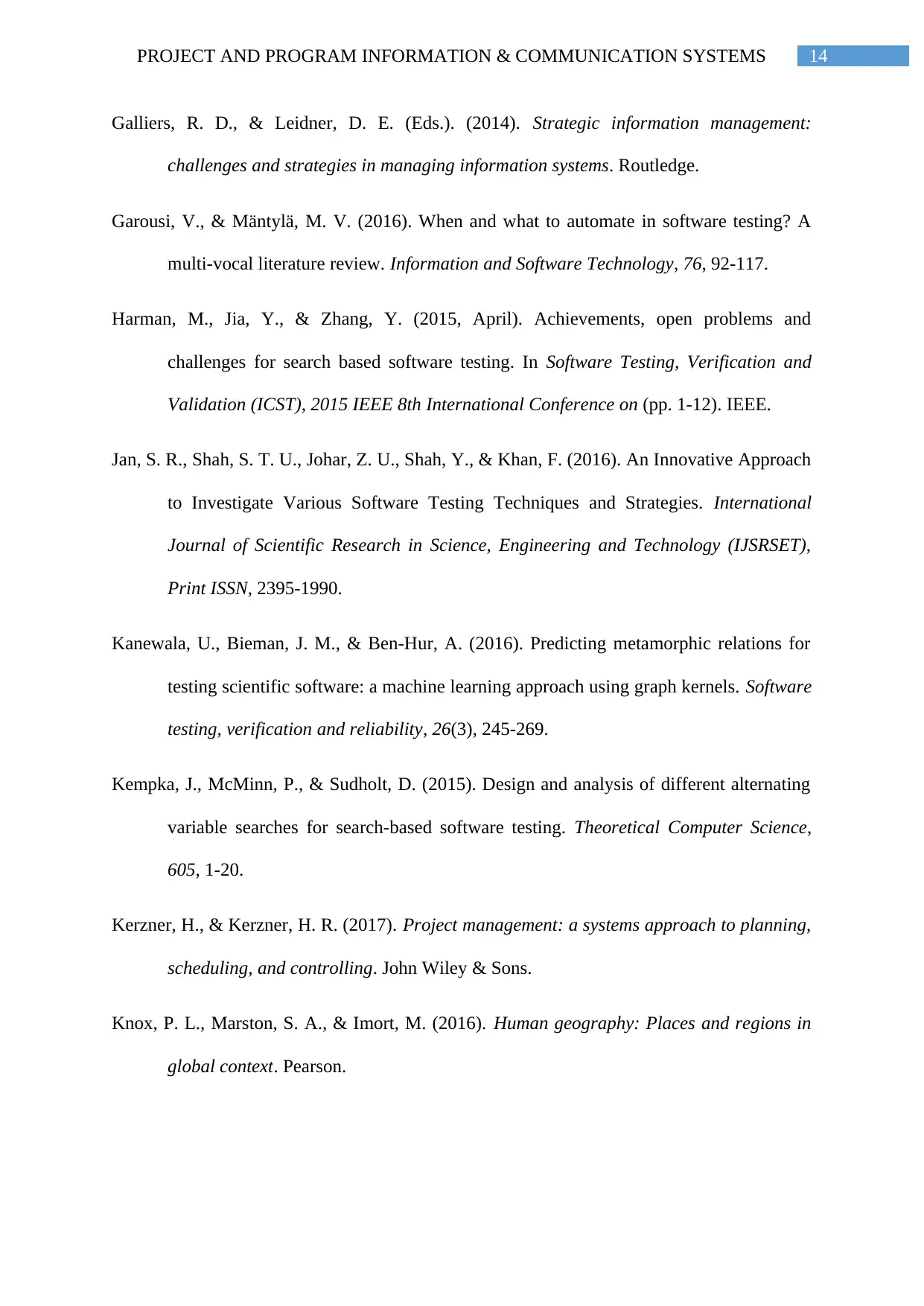
14PROJECT AND PROGRAM INFORMATION & COMMUNICATION SYSTEMS
Galliers, R. D., & Leidner, D. E. (Eds.). (2014). Strategic information management:
challenges and strategies in managing information systems. Routledge.
Garousi, V., & Mäntylä, M. V. (2016). When and what to automate in software testing? A
multi-vocal literature review. Information and Software Technology, 76, 92-117.
Harman, M., Jia, Y., & Zhang, Y. (2015, April). Achievements, open problems and
challenges for search based software testing. In Software Testing, Verification and
Validation (ICST), 2015 IEEE 8th International Conference on (pp. 1-12). IEEE.
Jan, S. R., Shah, S. T. U., Johar, Z. U., Shah, Y., & Khan, F. (2016). An Innovative Approach
to Investigate Various Software Testing Techniques and Strategies. International
Journal of Scientific Research in Science, Engineering and Technology (IJSRSET),
Print ISSN, 2395-1990.
Kanewala, U., Bieman, J. M., & Ben‐Hur, A. (2016). Predicting metamorphic relations for
testing scientific software: a machine learning approach using graph kernels. Software
testing, verification and reliability, 26(3), 245-269.
Kempka, J., McMinn, P., & Sudholt, D. (2015). Design and analysis of different alternating
variable searches for search-based software testing. Theoretical Computer Science,
605, 1-20.
Kerzner, H., & Kerzner, H. R. (2017). Project management: a systems approach to planning,
scheduling, and controlling. John Wiley & Sons.
Knox, P. L., Marston, S. A., & Imort, M. (2016). Human geography: Places and regions in
global context. Pearson.
Galliers, R. D., & Leidner, D. E. (Eds.). (2014). Strategic information management:
challenges and strategies in managing information systems. Routledge.
Garousi, V., & Mäntylä, M. V. (2016). When and what to automate in software testing? A
multi-vocal literature review. Information and Software Technology, 76, 92-117.
Harman, M., Jia, Y., & Zhang, Y. (2015, April). Achievements, open problems and
challenges for search based software testing. In Software Testing, Verification and
Validation (ICST), 2015 IEEE 8th International Conference on (pp. 1-12). IEEE.
Jan, S. R., Shah, S. T. U., Johar, Z. U., Shah, Y., & Khan, F. (2016). An Innovative Approach
to Investigate Various Software Testing Techniques and Strategies. International
Journal of Scientific Research in Science, Engineering and Technology (IJSRSET),
Print ISSN, 2395-1990.
Kanewala, U., Bieman, J. M., & Ben‐Hur, A. (2016). Predicting metamorphic relations for
testing scientific software: a machine learning approach using graph kernels. Software
testing, verification and reliability, 26(3), 245-269.
Kempka, J., McMinn, P., & Sudholt, D. (2015). Design and analysis of different alternating
variable searches for search-based software testing. Theoretical Computer Science,
605, 1-20.
Kerzner, H., & Kerzner, H. R. (2017). Project management: a systems approach to planning,
scheduling, and controlling. John Wiley & Sons.
Knox, P. L., Marston, S. A., & Imort, M. (2016). Human geography: Places and regions in
global context. Pearson.
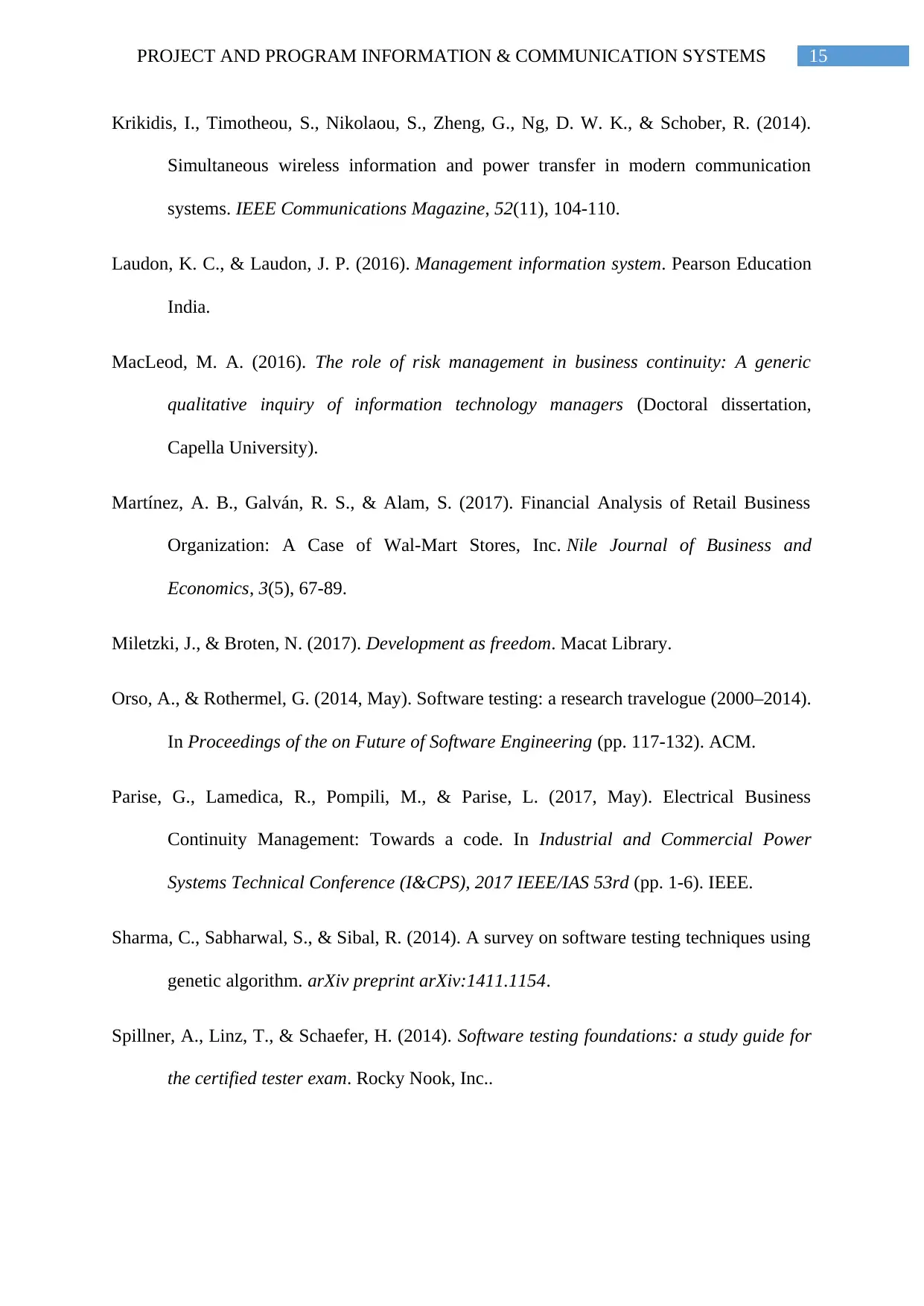
15PROJECT AND PROGRAM INFORMATION & COMMUNICATION SYSTEMS
Krikidis, I., Timotheou, S., Nikolaou, S., Zheng, G., Ng, D. W. K., & Schober, R. (2014).
Simultaneous wireless information and power transfer in modern communication
systems. IEEE Communications Magazine, 52(11), 104-110.
Laudon, K. C., & Laudon, J. P. (2016). Management information system. Pearson Education
India.
MacLeod, M. A. (2016). The role of risk management in business continuity: A generic
qualitative inquiry of information technology managers (Doctoral dissertation,
Capella University).
Martínez, A. B., Galván, R. S., & Alam, S. (2017). Financial Analysis of Retail Business
Organization: A Case of Wal-Mart Stores, Inc. Nile Journal of Business and
Economics, 3(5), 67-89.
Miletzki, J., & Broten, N. (2017). Development as freedom. Macat Library.
Orso, A., & Rothermel, G. (2014, May). Software testing: a research travelogue (2000–2014).
In Proceedings of the on Future of Software Engineering (pp. 117-132). ACM.
Parise, G., Lamedica, R., Pompili, M., & Parise, L. (2017, May). Electrical Business
Continuity Management: Towards a code. In Industrial and Commercial Power
Systems Technical Conference (I&CPS), 2017 IEEE/IAS 53rd (pp. 1-6). IEEE.
Sharma, C., Sabharwal, S., & Sibal, R. (2014). A survey on software testing techniques using
genetic algorithm. arXiv preprint arXiv:1411.1154.
Spillner, A., Linz, T., & Schaefer, H. (2014). Software testing foundations: a study guide for
the certified tester exam. Rocky Nook, Inc..
Krikidis, I., Timotheou, S., Nikolaou, S., Zheng, G., Ng, D. W. K., & Schober, R. (2014).
Simultaneous wireless information and power transfer in modern communication
systems. IEEE Communications Magazine, 52(11), 104-110.
Laudon, K. C., & Laudon, J. P. (2016). Management information system. Pearson Education
India.
MacLeod, M. A. (2016). The role of risk management in business continuity: A generic
qualitative inquiry of information technology managers (Doctoral dissertation,
Capella University).
Martínez, A. B., Galván, R. S., & Alam, S. (2017). Financial Analysis of Retail Business
Organization: A Case of Wal-Mart Stores, Inc. Nile Journal of Business and
Economics, 3(5), 67-89.
Miletzki, J., & Broten, N. (2017). Development as freedom. Macat Library.
Orso, A., & Rothermel, G. (2014, May). Software testing: a research travelogue (2000–2014).
In Proceedings of the on Future of Software Engineering (pp. 117-132). ACM.
Parise, G., Lamedica, R., Pompili, M., & Parise, L. (2017, May). Electrical Business
Continuity Management: Towards a code. In Industrial and Commercial Power
Systems Technical Conference (I&CPS), 2017 IEEE/IAS 53rd (pp. 1-6). IEEE.
Sharma, C., Sabharwal, S., & Sibal, R. (2014). A survey on software testing techniques using
genetic algorithm. arXiv preprint arXiv:1411.1154.
Spillner, A., Linz, T., & Schaefer, H. (2014). Software testing foundations: a study guide for
the certified tester exam. Rocky Nook, Inc..
Secure Best Marks with AI Grader
Need help grading? Try our AI Grader for instant feedback on your assignments.
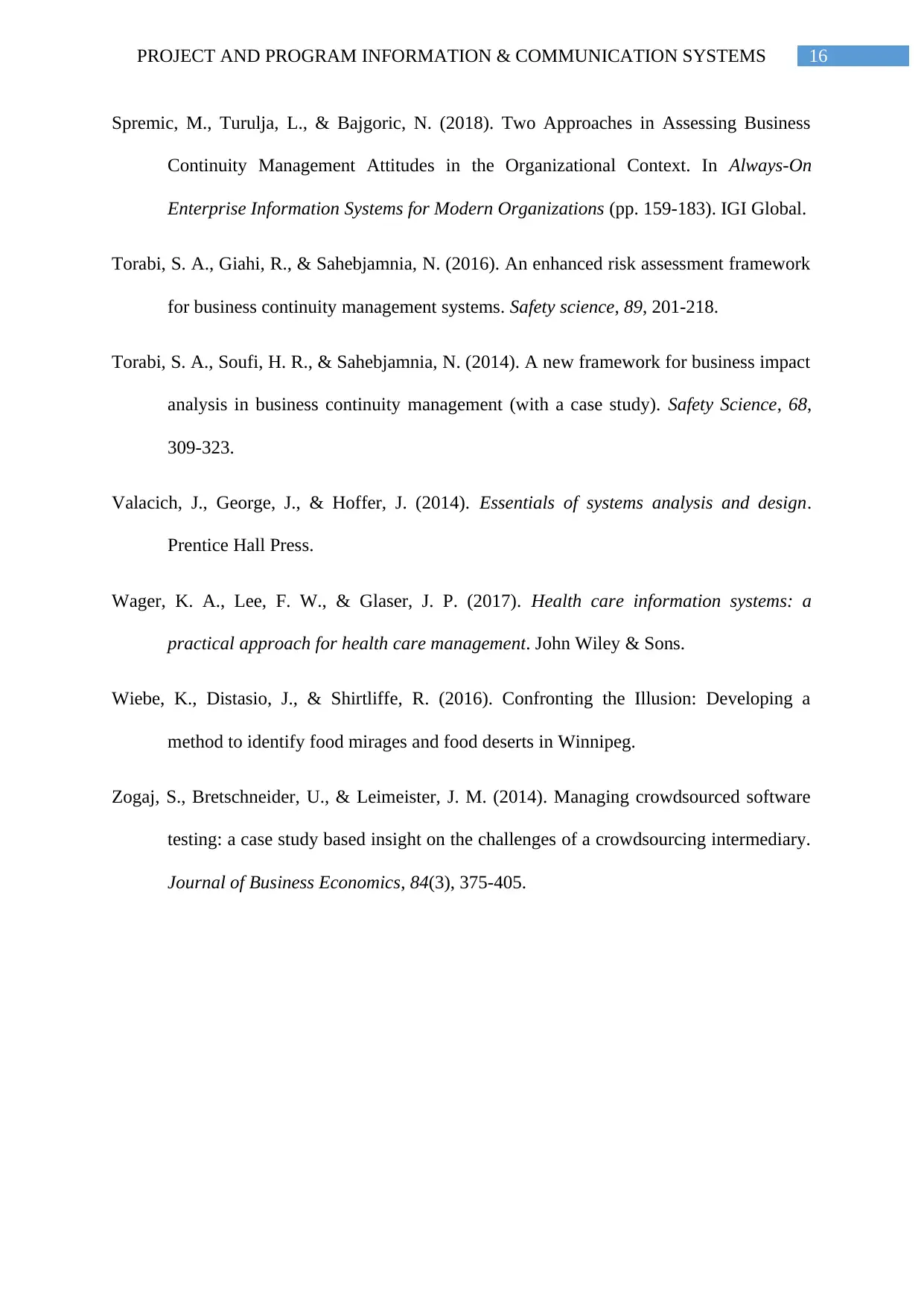
16PROJECT AND PROGRAM INFORMATION & COMMUNICATION SYSTEMS
Spremic, M., Turulja, L., & Bajgoric, N. (2018). Two Approaches in Assessing Business
Continuity Management Attitudes in the Organizational Context. In Always-On
Enterprise Information Systems for Modern Organizations (pp. 159-183). IGI Global.
Torabi, S. A., Giahi, R., & Sahebjamnia, N. (2016). An enhanced risk assessment framework
for business continuity management systems. Safety science, 89, 201-218.
Torabi, S. A., Soufi, H. R., & Sahebjamnia, N. (2014). A new framework for business impact
analysis in business continuity management (with a case study). Safety Science, 68,
309-323.
Valacich, J., George, J., & Hoffer, J. (2014). Essentials of systems analysis and design.
Prentice Hall Press.
Wager, K. A., Lee, F. W., & Glaser, J. P. (2017). Health care information systems: a
practical approach for health care management. John Wiley & Sons.
Wiebe, K., Distasio, J., & Shirtliffe, R. (2016). Confronting the Illusion: Developing a
method to identify food mirages and food deserts in Winnipeg.
Zogaj, S., Bretschneider, U., & Leimeister, J. M. (2014). Managing crowdsourced software
testing: a case study based insight on the challenges of a crowdsourcing intermediary.
Journal of Business Economics, 84(3), 375-405.
Spremic, M., Turulja, L., & Bajgoric, N. (2018). Two Approaches in Assessing Business
Continuity Management Attitudes in the Organizational Context. In Always-On
Enterprise Information Systems for Modern Organizations (pp. 159-183). IGI Global.
Torabi, S. A., Giahi, R., & Sahebjamnia, N. (2016). An enhanced risk assessment framework
for business continuity management systems. Safety science, 89, 201-218.
Torabi, S. A., Soufi, H. R., & Sahebjamnia, N. (2014). A new framework for business impact
analysis in business continuity management (with a case study). Safety Science, 68,
309-323.
Valacich, J., George, J., & Hoffer, J. (2014). Essentials of systems analysis and design.
Prentice Hall Press.
Wager, K. A., Lee, F. W., & Glaser, J. P. (2017). Health care information systems: a
practical approach for health care management. John Wiley & Sons.
Wiebe, K., Distasio, J., & Shirtliffe, R. (2016). Confronting the Illusion: Developing a
method to identify food mirages and food deserts in Winnipeg.
Zogaj, S., Bretschneider, U., & Leimeister, J. M. (2014). Managing crowdsourced software
testing: a case study based insight on the challenges of a crowdsourcing intermediary.
Journal of Business Economics, 84(3), 375-405.
1 out of 17
Related Documents
Your All-in-One AI-Powered Toolkit for Academic Success.
+13062052269
info@desklib.com
Available 24*7 on WhatsApp / Email
![[object Object]](/_next/static/media/star-bottom.7253800d.svg)
Unlock your academic potential
© 2024 | Zucol Services PVT LTD | All rights reserved.



